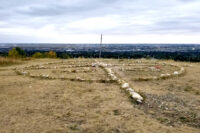Crossing the border
By Submitted Article on September 1, 2020.
SUBMITTED BY THE GALT MUSEUM AND ARCHIVES
In 1865, the American Civil War ended and around the same time a gold rush in Montana attracted primarily young men to the region in search of gold and opportunity. Fur traders in Montana had been illegally trading whisky with the Blackfoot in exchange for buffalo robes. In the late 1860s the U.S. government cracked down on the illegal whisky trade in Montana, which inspired many traders to flee the law and continue the trade across the border in Canada.
American free traders Alfred B. Hamilton and John J. Healy left Fort Benton in December 1869. They travelled for several weeks along what would later become the Whoop-Up Trail. In early 1870, they set up a trading post at the junction of the St. Mary and Belly, or Oldman, Rivers.
They received permission from Kainai leader Aka’kitsipimi’otas (Many Spotted Horses) to establish the fort at that location, which was a favourite wintering camp of the Niitsitapi (Real People or Blackfoot People).
For the next several years, Fort Whoop-Up became the centre of the American robe and whisky trade system in what is now southern Alberta. Other trading forts in the region included Slide Out, Standoff and Robbers’ Roost.
2020 marks 150 years since Fort Whoop-Up was established. The anniversary provides an occasion for rethinking how the history of the fort has been told. A lot of lore and stories have arisen regarding happenings at the Fort. Not all of the tales can be substantiated, but those that can be paint a complex picture of life on the prairies for American, Canadian and European traders and the Blackfoot and Métis who traded with them.
Your old photos, documents and artifacts might have historical value. Please contact the Galt Museum and Archives before destroying them.
8-7




